Design of Triaxial Tests with Polymer Matrix Composites
Abstract
:1. Introduction
2. Materials and Methods
2.1. Material, Equipment and Geometry of the Specimens
2.2. Supporting Fixture
2.3. Determination of the Triaxial Strain State
2.4. Numerical Model
3. Results
3.1. Design of the Specimen: Influence of the Fillet Radii
3.1.1. Influence of the Fillet Radius in Geometry A
3.1.2. Influence of the Fillet Radii in Geometry B
3.1.3. Comparison of Geometries A and B
- The highest value of the maximum principal stress (expressed in absolute value) is produced in both cases out of the measurement region, but the lowest value is achieved in geometry A.
- Comparing the maximum principal stress evolution along the paths of geometry A and B, higher homogeneity is found in geometry B.
3.2. Influence of the Supporting Fixture
4. Discussion
4.1. Geometry A for the CTC Case: Loading Scenario −50/50/−50
4.2. Geometry A for the CTC Case: Loading Scenario −50/25/−50
5. Conclusions
Author Contributions
Funding
Institutional Review Board Statement
Informed Consent Statement
Data Availability Statement
Conflicts of Interest
References
- Smits, A.; Ramault, C.; Makris, A.; van Hemelrijck, D.; Clarke, A.; Williamson, C.; Gower, M.; Shaw, R.; Mera, R.; Lamkanfi, E.; et al. A review of biaxial test methods for composites. In Experimental Analysis of Nano and Engineering Materials and Structures; Springer: Berlin/Heidelberg, Germany, 2007; pp. 933–934. [Google Scholar]
- Welsh, J.; Adams, D. Biaxial and Triaxial Failure Strengths of 6061-T6 Aluminum and AS4/3501-6 Carbon/Epoxy Laminates Obtained by Testing Thickness-Tapered Cruciform Specimens. J. Compos. Technol. Res. 2001, 23, 111–121. [Google Scholar]
- Hinton, M.J.; Kaddour, A.S.; Soden, P.D. Failure Criteria in Fiber Reinforced Polymer Composites: The World-Wide Failure Exercise; Elsevier: Amsterdam, The Netherlands, 2004. [Google Scholar]
- Welsh, S.J.; Adams, D.F. An experimental investigation of the biaxial strength of IM6/3501-6 carbon/epoxy cross-ply laminates using cruciform specimens. Compos. Part A 2002, 33, 829–839. [Google Scholar] [CrossRef]
- Yu, Y.; Wan, M.; Xu, X.D. Design of a cruciform biaxial tensile specimen for limit strain analysis by FEM. J. Mater. Process. Tech. 2002, 123, 67. [Google Scholar] [CrossRef]
- Smits, A.; van Hemelrijck, D.; Philippidis, T.P.; Cardon, A. Design of a cruciform specimen for biaxial testing of fibre reinforced composite laminates. Compos. Sci. Technol. 2006, 66, 964. [Google Scholar] [CrossRef]
- Van Hemelrijck, D.; Makris, A.; Ramault, C.; Lamkanfi, E.; van Paepegen, W.; Lecompte, D. Biaxial testing of fibre-reinforced composite laminates. Mech. Eng. Part L Design Appl. 2008, 222, 231. [Google Scholar] [CrossRef]
- Gower, M.R.L.; Shaw, R.M. Towards a planar cruciform specimen for biaxial characterisation of polymer matrix composites. J. Appl. Math. Mech. 2010, 24–25, 115–120. [Google Scholar] [CrossRef] [Green Version]
- Makris, A.; Vandenbergh, T.; Ramault, C.; van Hemelrijck, D.; Lamkanfi, E.; van Paepegen, W. Shape optimisation of a biaxially loaded cruciform specimen. Polym. Test 2010, 29, 216. [Google Scholar] [CrossRef]
- Welsh, J.S.; Mayes, J.S.; Biskner, A.C. 2-D Biaxial testing and failure predictions of IM7/977-2 carbon/epoxy quasi-isotropic laminates. Compos. Struct. 2006, 75, 60–66. [Google Scholar] [CrossRef]
- Lamkanfi, E.; van Paepegem, W.; Degrieck, J.; Ramault, C.; Makris, A.; van Hemelrijck, D. Strain distribution in cruciform specimens subjected to biaxial loading conditions. Part 2: Influence of geometrical discontinuities. Polym. Test 2010, 29, 132–138. [Google Scholar] [CrossRef]
- Serna Moreno, M.C.; López Cela, J.J. A Failure envelope under biaxial tensile loading for chopped glass-reinforced polyester composites. Compos. Sci. Tech. 2011, 72, 91–96. [Google Scholar]
- Serna Moreno, M.C.; Martinez Vicente, J.L.; López Cela, J.J. Failure strain and stress fields of a chopped glass-reinforced polyester under biaxial loading. Compos. Struct. 2013, 103, 27–33. [Google Scholar]
- Serna Moreno, M.C.; Curiel-Sosa, J.L.; Navarro-Zafra, J.; Martínez Vicente, J.L.; López Cela, J.J. Crack propagation in a chopped glass-reinforced composite under biaxial testing by means of XFEM. Compos. Struct. 2015, 219, 264–271. [Google Scholar] [CrossRef]
- Serna Moreno, M.C.; Martínez Vicente, J.L. In-plane shear failure properties of a chopped glass-reinforced polyester by means of traction–compression biaxial testing. Compos. Struct. 2015, 122, 440–444. [Google Scholar] [CrossRef]
- Serna Moreno, M.C.; Horta Muñoz, S. Elastic stability in biaxial testing with cruciform specimens subjected to compressive loading. Compos. Struct. 2020, 234, 111697. [Google Scholar] [CrossRef]
- ASTM D7181; Standard Test Method for Consolidated Drained Triaxial Compression Test for Soils. ASTM: West Conshohocken, PA, USA, 2011.
- ASTM D4767-11; Standard Test Method for Consolidated Undrained Triaxial Compression Test for Cohesive Soils. ASTM: West Conshohocken, PA, USA, 2011.
- ASTM D2850—03a; Standard Test Method for Unconsolidated-Undrained Triaxial Compression Test on Cohesive Soils. ASTM: West Conshohocken, PA, USA, 2007.
- Wronski, A.S.; Parry, T.V. Compressive failure and kinking in uniaxially aligned glass-resin composite under superimposed hydrostatic pressure. J. Mater. Sci. 1982, 17, 3656–3662. [Google Scholar] [CrossRef]
- Zinoviev, P.A.; Tsvetkov, S.V.; Kulish, G.G.; van den Berg, R.W.; Van Schepdael, L.J. The behaviour of high-strength unidirectional composites under tension with superposed hydrostatic pressure. Compos. Sci. Technol. 2001, 61, 1151–1161. [Google Scholar] [CrossRef]
- Parry, T.V.; Wronski, A.S. Kinking and compressive failure in uniaxially aligned carbon fibre composite tested under superimposed hydrostatic pressure. J. Mater. Sci. 1982, 17, 893–900. [Google Scholar] [CrossRef]
- Parry, T.V.; Wronski, A.S. The effect of hydrostatic pressure on the tensile properties of pultruded CFRP. J. Mater. Sci. 1985, 20, 2141–2147. [Google Scholar] [CrossRef]
- De Teresa, S.J.; Freeman, D.C.; Groves, S.E. The effects of through-thickness compression on the interlaminar shear response of laminate fiber composites. J. Comp. Mater. 2004, 38, 681–697. [Google Scholar] [CrossRef]
- Hinton, M.J.; Kaddour, A.S. Triaxial test results for fibre-reinforced composites: The Second World-Wide Failure Exercise benchmark data. J. Compos. Mater. 2012, 47, 653–678. [Google Scholar] [CrossRef]
- Kaddour, A.S.; Hinton, M.J. Maturity of 3D Failure Criteria for Fibre-Reinforced Composites: Comparison Between Theories and Experiments. J. Compos. Mater. 2013, 47, 925–966. [Google Scholar] [CrossRef]
- Welsh, S.; Adams, D.F. Development of an electromechanical triaxial test facility for composite materials. Exp. Mech. 2000, 40, 312–320. [Google Scholar] [CrossRef]
- Cavallaro, P.V.; Raynham, M.A.; Sadegh, A.M.; Franklin, N.J. Triaxial Tension Compression shear Testing Apparatus. U.S. Patent 7,051,600 B1, Washington, DC, USA, 2004. [Google Scholar]
- Calloch, S.; Marquis, D. Triaxial tension-compression tests for multiaxial cyclic plasticity. Int. J. Plast. 1999, 15, 521–549. [Google Scholar] [CrossRef]
- Comanici, A.M.; Goanta, V.; Barsanescu, P.D. Study of a Triaxial Specimen and a Review for the Triaxial Machines. In Proceedings of the XII International Congress “Machines, Technologies, Materials”, Varna, Bulgaria; 2015; Volume 1, pp. 16–19. Available online: https://www.researchgate.net/publication/301286141_STUDY_OF_A_TRIAXIAL_SPECIMEN_AND_A_REVIEW_FOR_THE_TRIAXIAL_MACHINES (accessed on 13 November 2021).
- Hayhurst, D.R.; Felce, I.D. Creep rupture under tri-axial tension. Eng. Fract. Mech. 1986, 25, 645–664. [Google Scholar] [CrossRef]
- What is Carbon Digital Light Synthesis™. Available online: https://www.carbon3d.com/carbon-dls-technology/ (accessed on 13 November 2021).
- Redmann, A.; Oehlmann, P.; Scheffler, T.; Kagermeier, L.; Osswald, T.A. Thermal curing kinetics optimization of epoxy resin in Digital Light Synthesis. Addit. Manuf. 2020, 32, 101018. [Google Scholar] [CrossRef]
- Kyowa. Kyowa Electronic Instruments Co. Available online: https://www.kyowa-ei.com/eng/ (accessed on 27 December 2021).
- López Cela, J.J. Mecánica de los Medios Continuos; Ediciones de la Universidad de Castilla—La Mancha: Cuenca, Spain, 1999. [Google Scholar]
- Dassault Systèmes. Abaqus/Standard User’s Manual; Dassault Systèmes: Vélizy-Villacoublay, France, 2021. [Google Scholar]
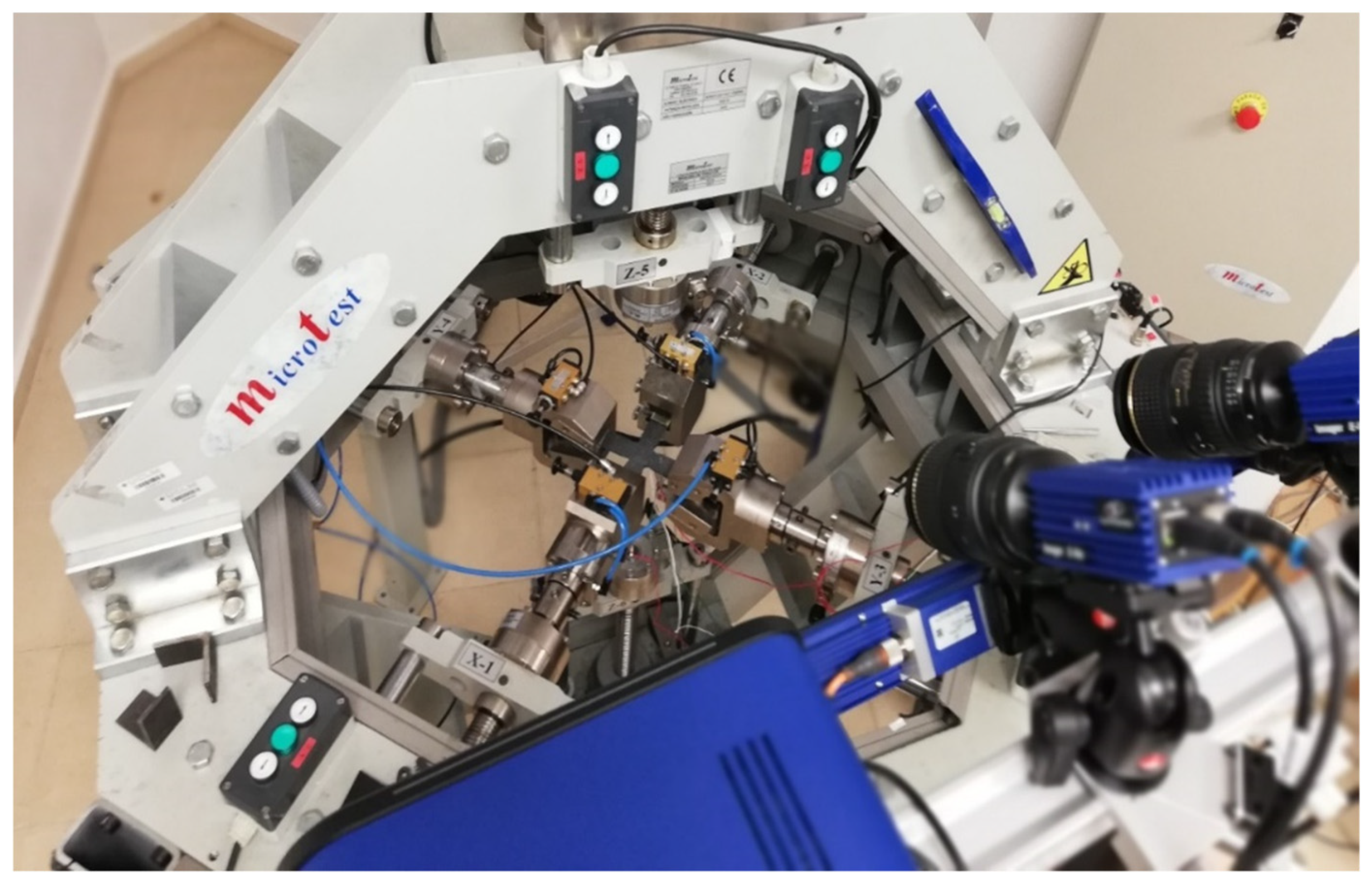





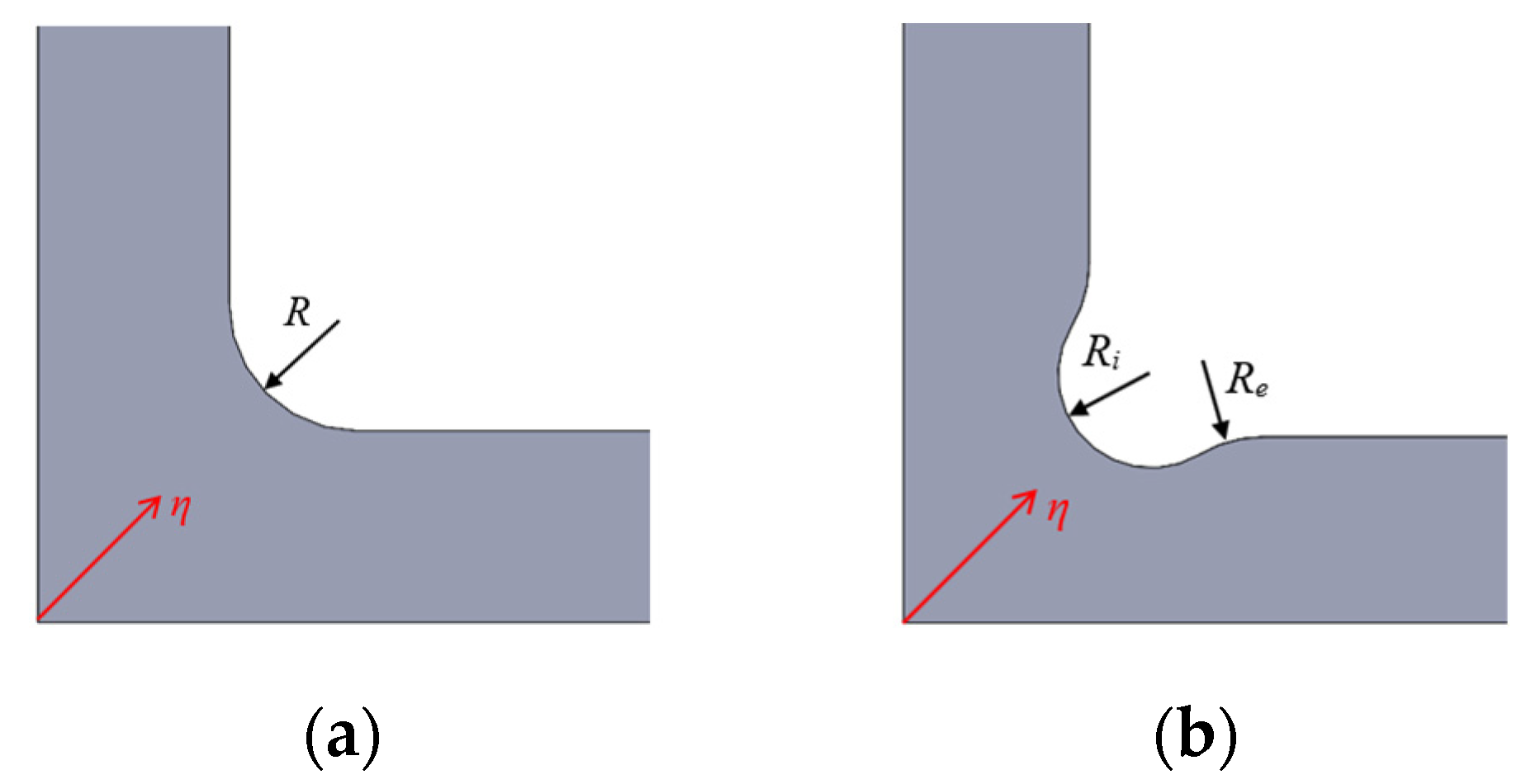

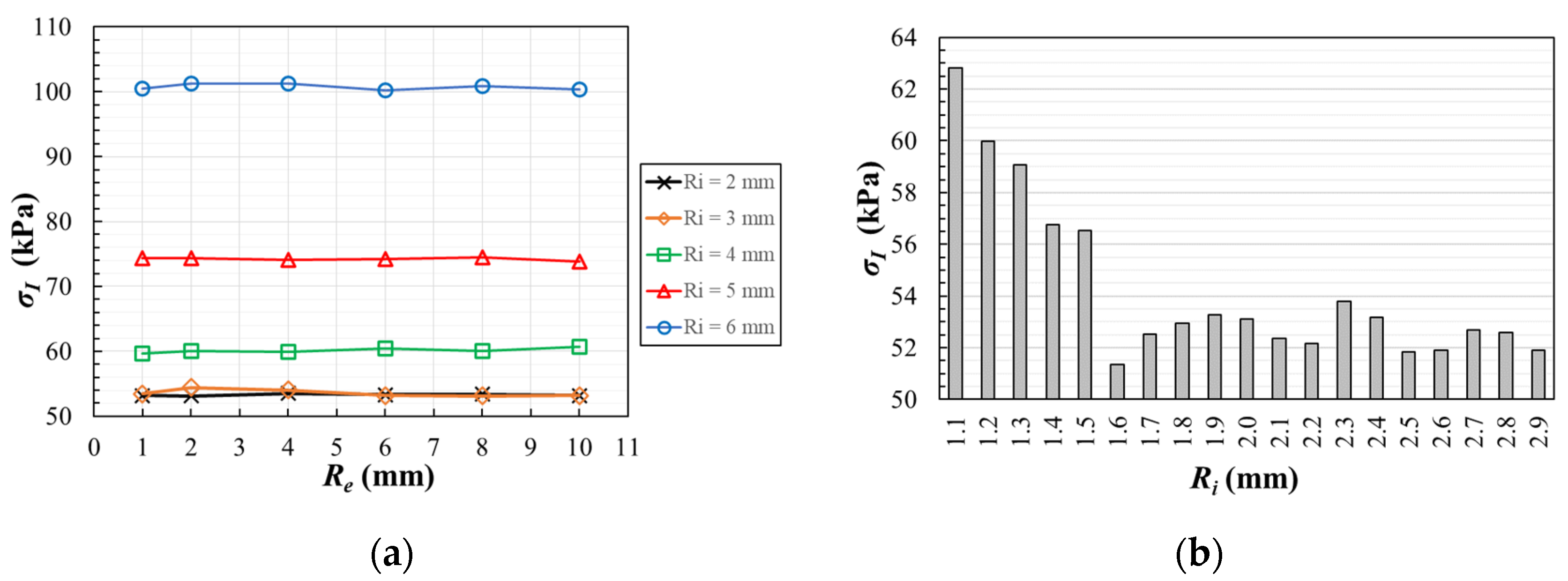

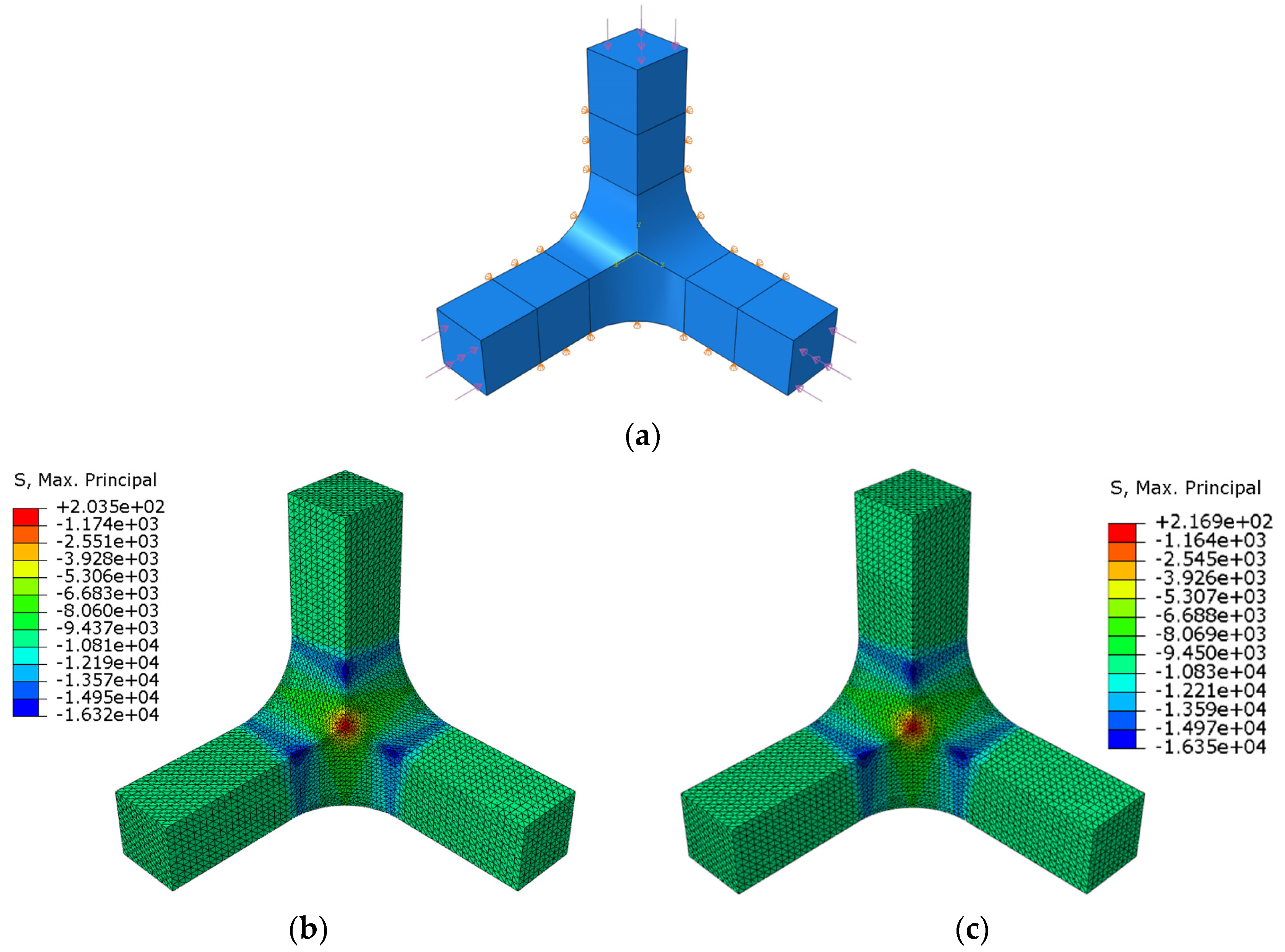
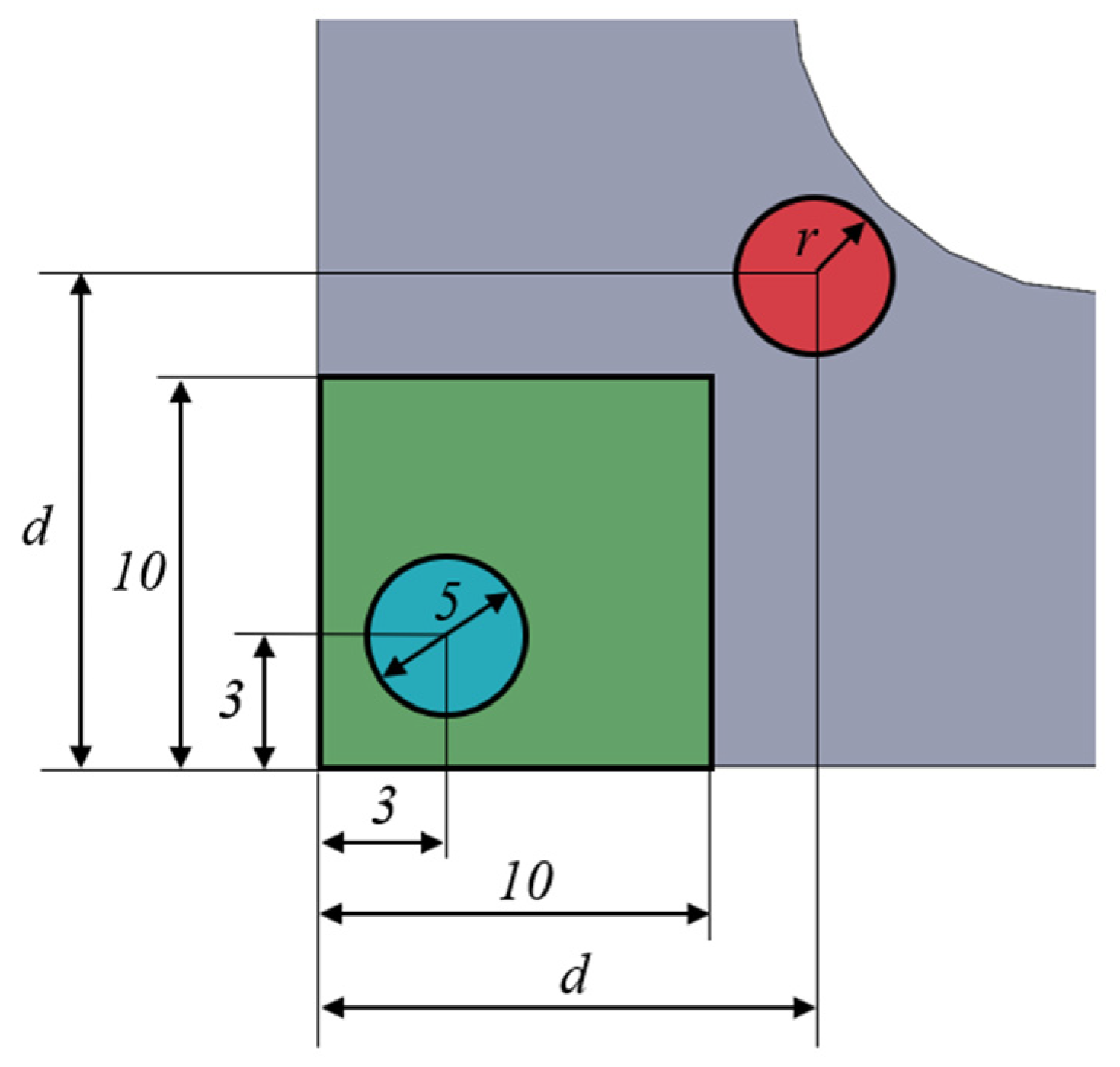

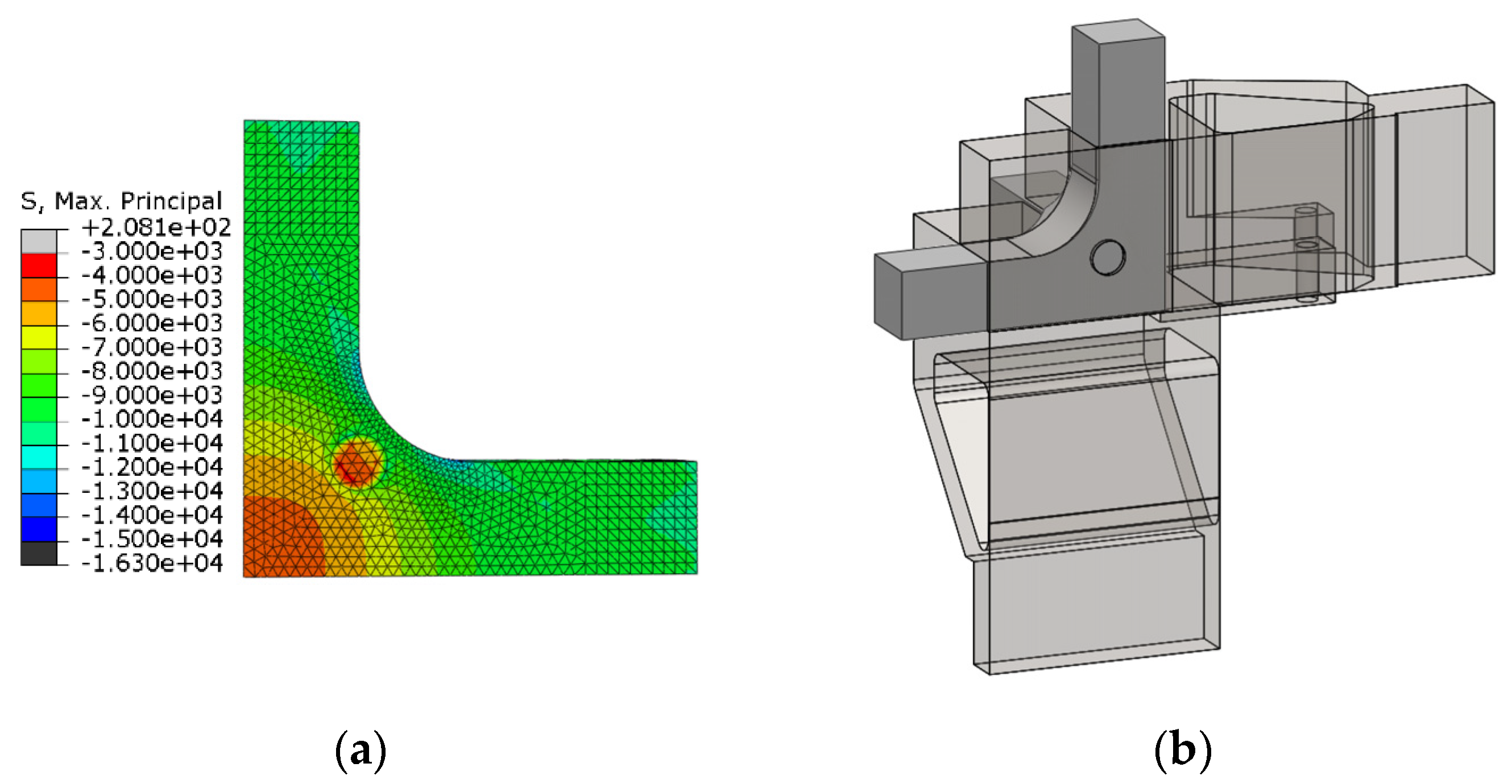




| R(mm) | 0.5 | 1.0 | 2.0 | 4.0 | 6.0 | 8.0 | 10.0 | 12.0 | 14.0 | 16.0 | 18.0 | 20.0 | 22.0 | 24.0 | 26.0 | 28.0 |
| 1.05 σ0 at-coordinate (mm) | 5.1 | 4.6 | 4.2 | 3.5 | 3.0 | 2.9 | 2.9 | 2.7 | 2.4 | 2.4 | 2.3 | 2.8 | 2.8 | 2.9 | 2.8 | 2.9 |
| 1.1 σ0 at-coordinate (mm) | 5.9 | 5.7 | 5.5 | 5.2 | 4.7 | 4.7 | 4.2 | 4.2 | 4.0 | 3.9 | 3.9 | 3.8 | 3.8 | 3.7 | 3.8 | 3.8 |
| Ri (mm) | 1.1 | 1.2 | 1.3 | 1.4 | 1.5 | 1.6 | 1.7 | 1.8 | 1.9 | 2.0 | 2.1 | 2.2 | 2.3 | 2.4 | 2.5 | 2.6 | 2.7 | 2.8 | 2.9 |
| 1.05 σ0 at-coordinate (mm) | 6.2 | 6.1 | 5.7 | 5.6 | 5.6 | 5.6 | 5.5 | 5.3 | 5.0 | 4.8 | 4.8 | 4.7 | 4.5 | 4.4 | 4.3 | 4.1 | 4.0 | 4.0 | 3.9 |
| 1.1 σ0 at-coordinate (mm) | 6.7 | 6.5 | 6.4 | 6.4 | 6.5 | 6.2 | 6.1 | 5.9 | 5.8 | 5.6 | 5.5 | 5.5 | 5.5 | 5.3 | 5.1 | 4.8 | 4.8 | 4.7 | 4.8 |
Publisher’s Note: MDPI stays neutral with regard to jurisdictional claims in published maps and institutional affiliations. |
© 2022 by the authors. Licensee MDPI, Basel, Switzerland. This article is an open access article distributed under the terms and conditions of the Creative Commons Attribution (CC BY) license (https://creativecommons.org/licenses/by/4.0/).
Share and Cite
Serna Moreno, M.d.C.; Horta Muñoz, S.; Ruiz Gracia, A. Design of Triaxial Tests with Polymer Matrix Composites. Polymers 2022, 14, 837. https://doi.org/10.3390/polym14040837
Serna Moreno MdC, Horta Muñoz S, Ruiz Gracia A. Design of Triaxial Tests with Polymer Matrix Composites. Polymers. 2022; 14(4):837. https://doi.org/10.3390/polym14040837
Chicago/Turabian StyleSerna Moreno, María del Carmen, Sergio Horta Muñoz, and Alberto Ruiz Gracia. 2022. "Design of Triaxial Tests with Polymer Matrix Composites" Polymers 14, no. 4: 837. https://doi.org/10.3390/polym14040837






